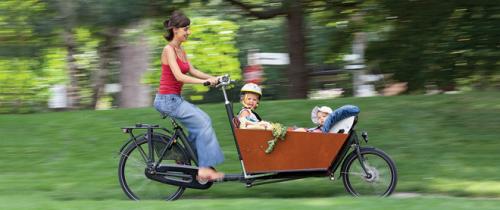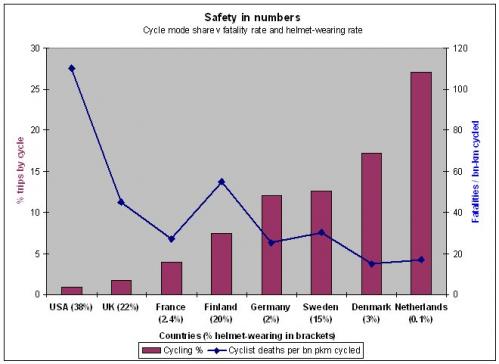
There aren't any statistics, but it certainly looks like there are lot more "bakfiets" / cargo bikes out on Canadian streets ("bakfiets" is Dutch for box bike and is a general term for any bike with a box for cargo or kids). Mainstream Maclean's magazine rarely pays any attention to urban alternative transportation, let alone bikes, but even they've noticed a proliferation of cargo bikes. It's not exactly booming but these bikes stand out in a crowd, particularly if a slight woman is pedalling a large bike with kids in the front. The cars move out of the way and pedestrians stop and stare.
My preference is for the "long john" variety, which has two wheels and a large box between the steering and the front wheel. It looks awkward but rides remarkably well. But there are a bunch of different types of cargo-carrying bikes, including the "long tail" (such as the XtraCycle, Yuba), the trike bakfiets (such as Nihola with two wheels in front), long johns, and "cycle trucks" (such as the WorkCycle Fr8 or Bilenky). Each of them has their own advantages and limitations.
All kinds of bakfietsen (the plural of bakfiets) are currently seeing a revival in Denmark and The Netherlands. Here in North America they've gained a small but enthusiastic following by parents and small business. I've even had inquiries from a military base in Ontario that wanted to know where they could buy a bakfiets in Canada.
Dimaras is one of a growing number of Canadians who have bought a cargo bicycle this summer so they can move about with both packages and passengers. In Vancouver, Mark Wilson, manager at Rain City Bikes, has sold twice as many of the oversized bicycles as he did last year. In Calgary, a city where sprawl is a barrier to commuting by bike despite the city’s network of trails, interest is growing, said Sean Carter, owner of BikeBike. “It’s got people thinking about how they can reduce their car usage. Maybe you can’t go car-free, but you can go car-light,” he said.
In Toronto, where you can spot the bicycles hauling, more often than not, children as well as stuff, Eric Kamphof of Curbside Cycle has sold all the cargo models he had imported from Holland this year. Now demand is high enough to bring over more. “People are obsessed with the fact that you can cycle with kids and groceries,” he said. “It’s nothing short of a paradigm shift.”
In the article I'm quoted as saying the long john was invented soon after the bicycle was invented in the late 19th century. To be more accurate, cargo delivery bike designs were invented and used in the late 19th century, but the long john variety is commonly said to have appeared sometime in the 1930s in Denmark, but similar cargo bikes have appeared even earlier in Holland (according to the modern bakfiets maker, Henry of WorkCycles - the maker of the bakfiets in the photo above). There was a lot of experimentation in bicycles and delivery bikes going on from the late 1800s to the 1930s and all sorts of interesting variations can be seen from old photos.
[img_assist|nid=4080|title=Courtesy of Henry Workcycles|desc=A long john precursor|link=node|align=center|width=500|height=210]
[img_assist|nid=4081|title=Traditional bakfiets|desc=These large trikes were used extensively but are not as popular with families as the long john|link=node|align=center|width=500|height=333]
Despite knowing so much about cargo bikes, I've never owned one. But I've borrowed them plenty of times to move lots of heavy objects (including my entire apartment once), and have used them while working with the City of Toronto. They take up room and are an investment (though much cheaper than a car). If I had kids I would see a definite reason for having one around.
At around $3,500, cargo bikes don’t come cheap (though a $1,500 model is available in Calgary). But those who ride them think they are a bargain. “They are not expensive. A car is expensive,” said Kamphof. The bicycles are fuelled by your lunch, and built well enough to last decades—possibly a lifetime, he said.


